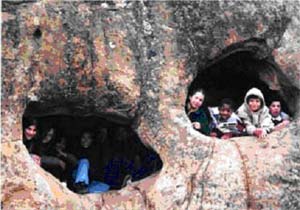 Students play in caves at rock city.
Students play in caves at rock city.
Photo by Jason StalterMount Diablo is a monstrous conniption fit of a geological formation that erupted into Northern California’s landscape 165 million years ago. It juts out of nowhere in the gentle rolling curves of a line of hills that runs from San Jose up to Martinez.
At 3,849 feet, its not particularly high, relative to most mountains, but the view from its peak is heavenly. This is especially true on a winter day after a storm has just come through and swept the haze from the surrounding area.
On the right day, you can go to the top of this grand mountain and look out to the west, beyond the Golden Gate Bridge, all the way to the Farallon Islands, an important shark breeding ground. If you look to the south, you will see Mount Hamilton, home of the James Lick Observatory, and one of the most, stable, air masses in the world. To the East, the Sierras will jut out of the horizon like an invading horde of giants. To the North you will see the winding, twisting snarls of the Delta. Beyond that one can see the nuclear reactors of Rancho Seco, just outside of Sacramento. Even further beyond that you might see Mount Lassen nestled in the Cascades, over 200 miles away.
While you are there, I highly recommend you do some hiking. There is an incredible variety of geological formations around, but my favorite is Rock City. It’s huge boulders are easily climbed, just watch out for the scorpions. The caves are a sure winner for the kids too, if you happen to bring them along.
While you are there, take a history lesson. The history of Mount Diablo is rich and colorful. It was a sacred mountain for the Miwok Indians who hunted there, and a sister of another sacred mountain to the west, Mt. Tamalpais. If you are lucky you might find remnants of rock fortifications they built, scattered about the mountainside.
